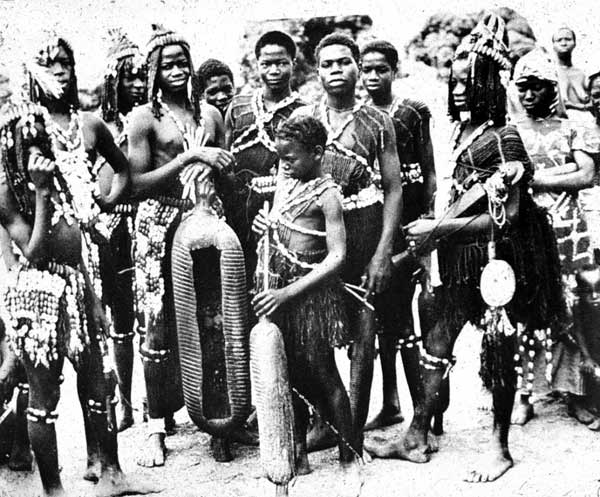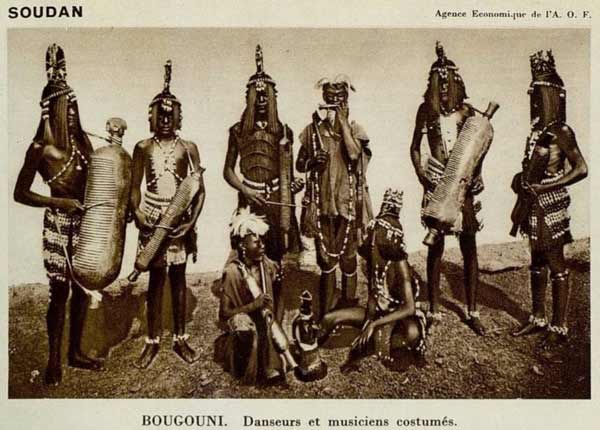DRUMS OF THE WORLD
Africa
bamana gong mali
Members of the nkènyè group of jo initiates. Photo by Viviana Pâques ["Bouffons sacrés du cercle de Bougouni (Soudan français)"
Journal de la Société des Africanistes 24 (1954): 63-110, p. II C].
Journal de la Société des Africanistes 24 (1954): 63-110, p. II C].
Bamana / Bambara gong Mali
"When the new jo members return to the village, they celebrate their successful completion of the initiation ordeal by showing off the jo songs and dances they have learned and the jo costumes they are now permitted to wear. They spend the next several months travelling to surrounding villages to put on similar performances and display their hard-earned knowledge of jo. For these journeys the new initiates travel in small groups, each with its own characteristic type of performance, distinguished by sculpture, costumes, songs, dances, musical instruments, and behavior. This photograph from the early 1950's (Members of the nkènyè group of jo initiates.Photo by Viviana Pâques ) shows initiates of the most common group, called nkènyè after the cylindrical wood instruments whose sounds accompany their performances. Each nkènyè troupe has instruments of several sizes, each producing a different tone."
excerpt from: Kate Ezra - Sculpture of the Bamana Jo Society.
copyright: Yale University Art Gallery. All rights reserved.
copyright: University of Iowa Stanley Museum of Art. All rights reserved.
Bibliography:
Colleyn, Jean-Paul, ed. Bamana : The Art of Existence in Mali. New York, Museum for African Art. 2001.
Colleyn, Jean-Paul : Bamana - Visions of Africa Series. 2008
Ezra, Kate : A Human Ideal in African Art - Bamana Figurative Sculpture. Washington, DC. National Museum of African Art, Smithsonian Institution, 1986.
Goldwater, Robert : Bambara Sculpture from the Western Sudan. New York, Museum of Primitive Art. 1960.
Tauxier, Louis : La religion bambara. Études Soudanaises. Paris
Zahan, Dominique : Sociétés d’initiation bambara. Le N’domo et le Korè. Paris and The Hague: Mouton, 1960.
"When the new jo members return to the village, they celebrate their successful completion of the initiation ordeal by showing off the jo songs and dances they have learned and the jo costumes they are now permitted to wear. They spend the next several months travelling to surrounding villages to put on similar performances and display their hard-earned knowledge of jo. For these journeys the new initiates travel in small groups, each with its own characteristic type of performance, distinguished by sculpture, costumes, songs, dances, musical instruments, and behavior. This photograph from the early 1950's (Members of the nkènyè group of jo initiates.Photo by Viviana Pâques ) shows initiates of the most common group, called nkènyè after the cylindrical wood instruments whose sounds accompany their performances. Each nkènyè troupe has instruments of several sizes, each producing a different tone."
excerpt from: Kate Ezra - Sculpture of the Bamana Jo Society.
copyright: Yale University Art Gallery. All rights reserved.
copyright: University of Iowa Stanley Museum of Art. All rights reserved.
Bibliography:
Colleyn, Jean-Paul, ed. Bamana : The Art of Existence in Mali. New York, Museum for African Art. 2001.
Colleyn, Jean-Paul : Bamana - Visions of Africa Series. 2008
Ezra, Kate : A Human Ideal in African Art - Bamana Figurative Sculpture. Washington, DC. National Museum of African Art, Smithsonian Institution, 1986.
Goldwater, Robert : Bambara Sculpture from the Western Sudan. New York, Museum of Primitive Art. 1960.
Tauxier, Louis : La religion bambara. Études Soudanaises. Paris
Zahan, Dominique : Sociétés d’initiation bambara. Le N’domo et le Korè. Paris and The Hague: Mouton, 1960.



